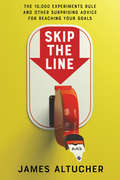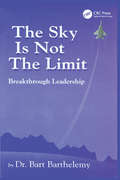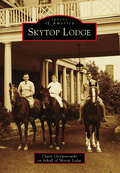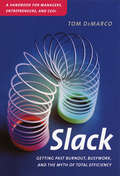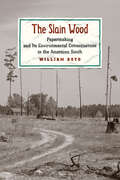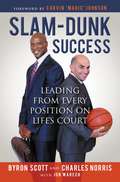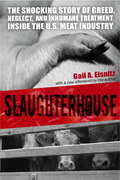- Table View
- List View
The Skinny: Marketing from Scratch
by David Strutton Kenneth ThompsonThe book takes established marketing principles and recasts them in new light by passing those principles through metaphorical market, environmental, and economic prisms to reveal truths about key marketing success factors that have always existed inside them. <p><p> During the seventeenth century Sir Isaac Newton did something similar when he passed white light through actual prisms to reveal colors that had been present all along inside the white light. One core marketing truth, one new color, was revealed through the passages. We call the new color The Skinny. <p><p> The book provides accurate and timely information and actual insights about marketing principles that most folks do not and never will know.
Skip the Line: The 10,000 Experiments Rule and Other Surprising Advice for Reaching Your Goals
by James AltucherThe entrepreneur, angel investor, and bestselling author of Choose Yourself busts the 10,000-hour rule of achieving mastery, offering a new mindset and dozens of techniques that will inspire any professional—no matter their age or managerial level—to pursue their passions and quickly acquire the skills they need to succeed and achieve their dreams.We live in a hierarchical world where experience has traditionally been the key to promotion. But that period is over! Straight, clear-cut career trajectories no longer exist. Industries disappear, job descriptions change, and people’s interests and passions evolve. The key to riding this wave, entrepreneur James Altucher advises, is to constantly be curious about what’s next, to be comfortable with uncertainty so you can keep navigating the rough waters ahead, and most important, to pursue the things that interest you.In Skip the Line, he reveals how he went from struggling and depressed to making his personal, financial, and creative dreams come true, despite—and perhaps due to—his many failures along the way. Altucher combines his personal story with concrete—and unorthodox—insights that work. But Skip the Line isn’t about hacks and shortcuts—it’s about transforming the way you think, work, and live, letting your interests guide your learning, time, and resources. It’s about allowing yourself to do what comes naturally; the more you do what you love, the better you do it. While showing you how to approach change and crisis, Altucher gives you tools to help easily execute ideas, become an expert negotiator, attract the attention of those around you, scale promising ideas, and improve leadership—all of which will catapult you higher than you ever thought possible and at a speed that everyone will tell you is impossible.
Skirt Strategies: 249 Success Tips for Women in Leadership
by Katie Snapp Carol WightSkirt Strategies Second Edition (2012) offers a refreshing approach to leadership ideas, techniques, and reminders for women in positions of influence. Inspiring, interesting, and filled with ideas and reminders for keeping you on top of your leadership style. Use Skirt Strategies for conducting mentoring sessions, leading discussions in women's network groups or mastermind meetings, starting a book club at work, or journaling your personal leadership trek. Skirt Strategies is filled with over 200 pages of leadership techniques that address your style, situations with male-dominated workplaces, effective approaches to difficult situations, and how to avoid the pitfalls of a typical female leader. Some tips remind you of the critical fundamentals for anyone needing to maintain their influence, while others take you to a more challenging level. Occasionally you'll see a light-hearted no-brainer that we enjoy sharing. This is a terrific resource for initializing a women's network discussion, as well as a rich resource for scheduling mentoring sessions around. You'll never be at a loss again for a topic to spark a lively interaction.
SKS and the AP Microfinance Crisis
by Yannick Saleman Shawn ColeSKS, India's leading microfinance firm, is challenged when politicians declaim microfinance as exploitation of the poor and severely restrict business practices.
SKS Microfinance
by Shawn Cole Theresa ChenVikram Akula, CEO of SKS Microfinance, seeks a venture capital investment to fund his firm. SKS, one of the largest and fastest growing microfinance institutions in India, is a profitable, for profit institution with a social mission. In what is one of the first commercial financing deals in the world, Akula must decide at what value to sell equity in SKS, and to whom to sell it. The case focuses on valuation, which is difficult because at the time there are no publicly traded comparable companies, and the strategic aspects of raising money.
SKS Microfinance (Abridged)
by Shawn Cole Theresa ChenVikram Akula, CEO of SKS Microfinance, seeks a venture capital investment to fund his firm. SKS, one of the largest and fastest growing microfinance institutions in India, is a profitable, for-profit institution with a social mission. In what is one of the first commercial financing deals in the world, Akula must decide at what value to sell equity in SKS, and to whom to sell it. The case focuses on valuation, which is difficult because at the time there are no publicly traded comparable companies, and the strategic aspects of raising money.
Sky Air, Inc.
by Paul A. GompersConcerns a fictitious airline company and examines the moral hazard situation that results within a firm. Provides an opportunity to discuss corporate governance and contracting under uncertainty.
Sky Deutschland-Bidding for Sports Rights (A)
by Felix Oberholzer-Gee Renate Imoberdorf Sascha L. Schmidt Sebastian KoppersCarsten Schmidt, CEO of Sky Deutschland, needs to prepare for the auction of German soccer rights. Much was at stake. Not only was soccer the most widely watched sport in Germany, the company had long advertised that only Sky showed "every game, every goal." In evaluating his company's bid, Schmidt had to consider not only the intrinsic value of the media rights but also how his bidding strategy would influence competition in the German media industry. Was it a good idea to keep OTT players out of the market? What was the right amount to bid?
Sky Deutschland-Bidding for Sports Rights (B)
by Felix Oberholzer-Gee Sascha L. Schmidt Sebastian KoppersCarsten Schmidt, CEO of Sky Deutschland, needs to prepare for the auction of German soccer rights. Much was at stake. Not only was soccer the most widely watched sport in Germany, the company had long advertised that only Sky showed "every game, every goal." In evaluating his company's bid, Schmidt had to consider not only the intrinsic value of the media rights but also how his bidding strategy would influence competition in the German media industry. Was it a good idea to keep OTT players out of the market? What was the right amount to bid?
The Sky is Not the Limit: Breakthrough Leadership
by Robert BarthelemyWhat exactly is "breakthrough leadership"? Quite simply, it's an approach to performance aimed at transcending limitations and maximizing team potential. As the author points out, the process of innovation and high performance is not random or haphazard. The limitations and barriers that commonly get in the way of success can be overcome-if we use the right leadership techniques.And that's just what Dr. Bart Barthelemy, one of the nation's leaders in the fields of aeronautics and astronautics, discusses in The Sky Is Not the Limit-leadership techniques that work, and work consistently. Barthelemy has used his years of management experience to come up with a practical, results-driven guide to leadership based on the ideas of competitive collaboration and structured flexibility.Whether you're a manager, supervisor, team leader or consultant, The Sky Is Not the Limit can help you achieve significant breakthroughs in performance and productivity. You can use its proven tips and techniques to lead your teams to new heights of excellence. Remember, the sky is not the limit-not for airplanes, not for this planet, not for our organizations and not for any of us!
Skyhook Wireless
by Shikhar Ghosh Thomas R. EisenmannTed Morgan, the founder of Skyhook Wireless just received a call from Steve Jobs of Apple asking for a meeting. Ted must decide how to prepare for a meeting that could finally give Skyhook an anchor customer. Ted and his team have worked for three years to build a new approach to location based services that uses WiFi rather than the well-established satellite based GPS technology. Skyhook's approach is more accurate than GPS in urban areas and, unlike GPS, it works indoors. Yet, large device manufacturers are reluctant to be the first ones to use it. Skyhook has no customers. The board and investors are getting restless. Should Ted offer Steve Jobs a free license, or pay him for Apple's user base - or should he insist on a substantial license fee? The case examines the challenges faced by entrepreneurs in creating a technology-based company and in getting market traction against an established standard.
Skyrocket Your Business with Social Media Branding: Personalize, Increase, and Grow Demand for your Brand
by Isis BradfordSkyrocket Your Business with Social Media Branding"As a next-generation leader and trusted voice in the digital arena, Isis Bradford provides the blueprint to take your brand from the ground floor all the way to the top.” —Pauleanna Reid, founder of WritersBlok and nationally published journalistSkyrocket Your Business with Social Media Branding guides you on how to start and build your brand and business. Through social media branding and selling digital products, you can scale your business to be extremely lucrative—let’s get started!Grow your business and your brand. Social media strategist and content expert Isis Bradford created this guide book to help small business owners acclimate to social media branding and promoting digital products and goods. Learn how to utilize an instagram following to your advantage without a business development manager using Bradford’s The P.A.I.D. Equation method. P.A.I.D stands for how to (P)personalize the experience of your audience, bring (A)awareness to your business daily, create an (I)intimate relationship with those who are ready to shop from you, and increase (D)demand for purchases!Social media and business strategies made simple. Engage with your audience using updated strategies on social media branding. Learn how to personalize intended experiences for your audience, build brand awareness daily on social media, and inspire your audience to purchase any of your digital products and courses without famous influencers. Inside, you’ll find:Marketing and social media branding guidelines to grow your businessBusiness strategies to inspire purchases of your digital products and coursesAn online business book taking digital serial entrepreneurs to the next levelIf you liked Hook Point, The Nuclear Effect, or The Fearless Woman's Guide to Starting a Business, you’ll love Skyrocket Your Business with Social Media Branding.
The Sky's the Limit: Passion and Property in Manhattan
by Steven GainesOutlandish displays of ego, outrageous behavior, blood feuds, status hunger, and conspicuous consumption dominate the realm of New York City luxury real estate. THE SKY'S THE LIMIT offers the ultimate look inside the world of the super-rich from Barbra Streisand, Jerry Seinfeld, and Gloria Vanderbilt to Steven Spielberg, Tommy Hilfiger, and Madonna as it reveals the amazing lengths to which some people will go to live in the right zip code.
Skytop Lodge
by Skytop Lodge Claire GierwatowskiSurrounded by the natural beauty of mountain lakes, streams, and cascading waterfalls, the historic Skytop Lodge resort sits on 5,500 pristine acres in the heart of the Poconos. Developers of the estate cultivated this aesthetic when they hired the Olmsted Brothers landscape architecture firm to site the main building and design Skytop's gardens. Planned during the Roaring Twenties, Skytop first opened its doors in June 1928, just one year before the stock market crash that began the Great Depression. Despite that challenge and others, the classic silhouette of the Dutch Colonial Revival lodge has continued to greet guests for almost 90 years. Founder and general manager Samuel H. Packer laid the foundation for Skytop's success through his tireless efforts in organizing talent, such as golf pro Harold Calloway, and arranging endless events to build Skytop's reputation as a premiere destination "High in the Poconos."
Slack
by Tom DemarcoTo most companies, efficiency means profits and growth. But what if your "efficient" company--the one with the reduced headcount and the "stretch" goals--is actually slowing down and losing money? What if your employees are burning out doing the work of two or more people, leaving them no time for planning, prioritizing, or even lunch? What if you're losing employees faster than you can hire them? What if your superefficient company is suddenly falling behind?Tom DeMarco, a leading management consultant to both Fortune 500 and up-and-coming companies, has discovered a counterintuitive principle that explains why efficiency improvement can sometimes make a company slow. If your real organizational goal is to become fast (responsive and agile), then he proposes that what you need is not more efficiency, but more slack. What is "slack"? Slack is the degree of freedom in a company that allows it to change. It could be something as simple as adding an assistant to a department, letting high-priced talent spend less time at the photo copier and more time making key decisions. Slack could also appear in the way a company treats employees: instead of loading them up with overwork, a company designed with slack allows its people room to breathe, increase effectiveness, and reinvent themselves.In thirty--three short chapters filled with creative learning tools and charts, you and your company can learn how to: make sense of the Efficiency/Flexibility quandary run directly toward risk instead of away from it strengthen the creative role of middle management make change and growth work together for even greater profitsA innovative approach that works for new- and old-economy companies alike, this revolutionary handbook will debunk commonly held assumptions about real-world management, and give you and your company a brand-new model for achieving and maintaining true effectiveness--and a healthier bottom line.From the Hardcover edition.
Slackonomics: Generation X in the Age of Creative Destruction
by Lisa ChamberlainGeneration X grew up in the 1980s, when Alex P. Keaton was going to be a millionaire by the time he was thirty, greed was good, and social activism was deader than disco. Then globalization and the technological revolution came along, changing everything for a generation faced with bridging the analog and digital worlds. Living in a time of “creative destruction” – when an old economic order is upended by a new one – has deeply affected everyday life for this generation; from how they work, where they live, how they play, when they marry and have children to their attitudes about love, humor, happiness, and personal fulfillment. Through a sharp and entertaining mix of pop and alt-culture, personal narrative, and economic analysis, author Lisa Chamberlain shows how Generation X has survived and even thrived in the era of creative destruction, but will now be faced with solving economic and environmental problems on a global scale.
Slade Co.
by Paul R. Lawrence John A. SeilerDescribes a conflict between the values and norms of a segment of an internal social system and those of management and the wider culture.
Slade Plating Department
by Linda A. HillDescribes a conflict between the values and norms of a segment of an internal social system and those of management and the wider culture. Includes decision opportunity. A rewritten version of an earlier case.
The Slain Wood: Papermaking and Its Environmental Consequences in the American South (Studies in Industry and Society)
by William BoydThe paper industry rejuvenated the American South—but took a heavy toll on its land and people.When the paper industry moved into the South in the 1930s, it confronted a region in the midst of an economic and environmental crisis. Entrenched poverty, stunted labor markets, vast stretches of cutover lands, and severe soil erosion prevailed across the southern states. By the middle of the twentieth century, however, pine trees had become the region’s number one cash crop, and the South dominated national and international production of pulp and paper based on the intensive cultivation of timber.In The Slain Wood, William Boyd chronicles the dramatic growth of the pulp and paper industry in the American South during the twentieth century and the social and environmental changes that accompanied it. Drawing on extensive interviews and historical research, he tells the fascinating story of one of the region’s most important but understudied industries. The Slain Wood reveals how a thoroughly industrialized forest was created out of a degraded landscape, uncovers the ways in which firms tapped into informal labor markets and existing inequalities of race and class to fashion a system for delivering wood to the mills, investigates the challenges of managing large papermaking complexes, and details the ways in which mill managers and unions discriminated against black workers. It also shows how the industry’s massive pollution loads significantly disrupted local environments and communities, leading to a long struggle to regulate and control that pollution.
Slam-Dunk Success: Leading from Every Position on Life's Court
by Earvin Magic" Johnson Jon Warech Byron Scott Charlie Norrisp.p1 {margin: 0.0px 0.0px 0.0px 0.0px; font: 12.0px Geneva} span.Apple-tab-span {white-space:pre} Great leadership begins with great understanding. No one knows that better than basketball legend Byron Scott and lifelong business executive Charlie Norris who, respectively, won NBA championships and resurrected multimillion-dollar corporations by being team players no matter their position. Whether it's on the basketball court, in the boardroom, or in everyday life, getting to the heads and hearts of people is paramount to getting the most out of them. In SLAM-DUNK SUCCESS, Scott and Norris share their parallel formulas for victory and prove that, with the right tools, winning can happen anywhere. As a player Scott won three championships with the Los Angeles Lakers, and as coach he twice took the New Jersey Nets to the NBA Finals and won Coach of the Year honors with the New Orleans Hornets. With every team his role changed, but his winning mentality never faltered. As CEO of McKesson Water, Charlie Norris turned a $200 million-dollar company into a company that sold ten years later for $1.1 billion dollars and, as chairman of the board of Freshpet, he helped lead the start-up from early stage testing to become a publicly traded company with a market value of over $350 million. In each job, he led with the same amount of conviction and care. Their book-which grew from their unlikely friendship and realization that two men from completely different backgrounds could have the same leadership ideals-breaks down their keys to motivating others, negotiating deals, and creating prosperity from scratch. Their blueprint includes lessons on listening, turning failure into learning opportunities, and delegating authority with extreme precision. Leadership is a full-time job and Byron Scott and Charlie Norris's story is a guidebook for leaders in all fields and in any position looking to better both their careers and lives. Champions are formed when people make those around them better and this book shows how you can be a winner every day.
Slanket: Responding to Snuggie's Market Entry
by John Deighton Leora KornfeldHow does a pioneer in a new product category deal with the runaway success of a follower? Can search engine marketing and social media help? In 2008 Slanket CEO, Gary Clegg, found that his product, a blanket with sleeves, had been eclipsed by The Snuggie, another sleeved blanket. Snuggie made a brazen entry into the market with a $10 million spend on television infomercials. The Snuggie quickly became a pop culture phenomenon, talked about on popular television programs such as Oprah and The Tonight Show with Jay Leno, and paid mock tribute to on web sites such as YouTube, where hundreds of video parodies could be found. Clegg had been counting on building his Slanket brand. Will the coming of Snuggie mean the end of Slanket?
Slaughterhouse
by Gail A. EisnitzSlaughterhouse is the first book of its kind to explore the impact that unprecedented changes in the meatpacking industry over the last twenty-five years -- particularly industry consolidation, increased line speeds, and deregulation -- have had on workers, animals, and consumers. It is also the first time ever that workers have spoken publicly about what's really taking place behind the closed doors of America's slaughterhouses.In this new paperback edition, author Gail A. Eisnitz brings the story up to date since the book's original publication. She describes the ongoing efforts by the Humane Farming Association to improve conditions in the meatpacking industry, media exposés that have prompted reforms resulting in multimillion dollar appropriations by Congress to try to enforce federal inspection laws, and a favorable decision by the Supreme Court to block construction of what was slated to be one of the largest hog factory farms in the country.Nonetheless, Eisnitz makes it clear that abuses continue and much work still needs to be done.
Slave Agriculture and Financial Markets in Antebellum America: The Bank of the United States in Mississippi, 1831-1852 (Financial History #1)
by Richard Holcombe Kilbourne JrOffers the study of Antebellum southern slavery and the credit system. This work explains how the Bank of the United States supported the government's and the nation's credit abroad by providing seemingly limitless credit facilities to southern planters, especially in the territories along the lower Mississippi River.
The Slave Trade and Culture in the Bight of Biafra
by G. Ugo NwokejiThe Slave Trade and Culture in the Bight of Biafra dissects and explains the structure, dramatic expansion, and manifold effects of the slave trade in the Bight of Biafra. By showing that the rise of the Aro merchant group was the key factor in trade expansion, G. Ugo Nwokeji reinterprets why and how such large-scale commerce developed in the absence of large-scale centralized states. The result is the first study to link the structure and trajectory of the slave trade in a major exporting region to the expansion of a specific African merchant group - among other fresh insights into Atlantic Africa's involvement in the trade - and the most comprehensive treatment of Atlantic slave trade in the Bight of Biafra. The fundamental role of culture in the organization of trade is highlighted, transcending the usual economic explanations in a way that complicates traditional generalizations about work, domestic slavery, and gender in pre-colonial Africa.
Slavery and American Economic Development: A Novel (Walter Lynwood Fleming Lectures in Southern History)
by Gavin Wright"Slavery and American Economic Development is a small book with a big interpretative punch. It is one of those rare books about a familiar subject that manages to seem fresh and new." -- Charles B. Dew, Journal of Interdisciplinary History "A stunning reinterpretation of southern economic history and what is perhaps the most important book in the field since Time on the Cross.... I frequently found myself forced to rethink long-held positions." -- Russell R. Menard, Civil War History Through an analysis of slavery as an economic institution, Gavin Wright presents an innovative look at the economic divergence between North and South in the antebellum era. He draws a distinction between slavery as a form of work organization -- the aspect that has dominated historical debates -- and slavery as a set of property rights. Slave-based commerce remained central to the eighteenth-century rise of the Atlantic economy, not because slave plantations were superior as a method of organizing production, but because slaves could be put to work on sugar plantations that could not have attracted free labor on economically viable terms.Gavin Wright is William Robertson Coe Professor in American Economic History at Stanford University and the author of The Political Economy of the Cotton South and Old South, New South: Revolutions in the Southern Economy since the Civil War, winner of the Frank L. and Harriet C. Owsley Award of the Southern Historical Association. He has served as president of the Economic History Association and the Agricultural History Society.

